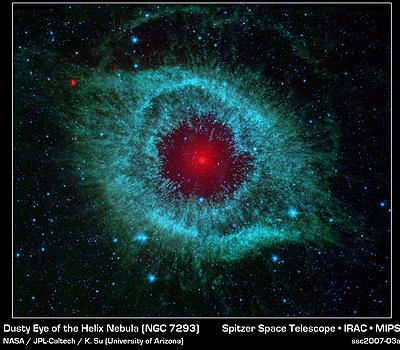The Spitzer Space Telescope imaged a white dwarf whose orbiting comets collided surrounded by dust and gas that look like a red pupil in the eye of a green monster

Collisions between comets can throw up such a large amount of dust that it can be observed around a dead star.
A bunch of freaking comets are colliding and kicking up dust around a dead star, according to an image taken by the Spitzer Space Telescope. The dead star is in the center of the Spiral Nebula - one of the most photographed nebulae, which looks like
"We were surprised to see so much dust around this star," said Dr. Kate Sue of the University of Arizona in Tucson, lead researcher on the paper, which is due to appear in the March 1 issue of the Astrophysics Journal Letters. "The dust must come from comets that survived the death of their sun." Sue said in a press release issued by the Spitzer Space Telescope Science Institute.
This surprised astronomers, because when the star dies and sheds its outer layer, all the dust in the system should fly away. A preferred explanation is that the dust is fresh and originated from comets that collided with each other at the outer edges of the system centered on a white dwarf. The dead white star is at the center of the Helix Nebula.
Eventually, our Sun will also become a white dwarf. Medium- or low-mass stars become white dwarfs after they have consumed the hydrogen that is the fuel for thermonuclear reactions. Towards the end of the nuclear burning phase, the star emits most of the material in its outer layer and forms a planetary nebula. Only the hot core of the star remains.
The Helix Nebula is a flickering cloud of gas that resembles a mysterious giant eye. The nebulous dead star appears as a dot in the center of the nebula, like a red pupil in the eye of a green monster. The nebula is about 700 light years away in the direction of the constellation Aquarius.
The radiation from the hot core of the dead star heats the receding material and causes it to glow with vividly colored phosphorescent light. The Spitzer space telescope, which photographs in the infrared range, was able to photograph the glow of the dust surrounding the body of the star at a distance of 35-150 astronomical units (an astronomical unit is the average distance of the Earth from the Sun - 150 million km).
For the previous news about this nebula - The Eye of God - the answer to the whimsical email

2 תגובות
That's not true, the nebula doesn't really look like that, it's an infrared photograph.
The real nebula looks like this:
http://upload.wikimedia.org/wikipedia/commons/b/b1/NGC7293_(2004).jpg